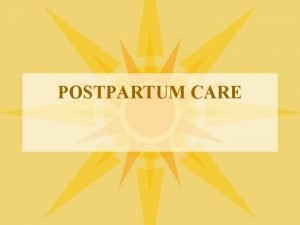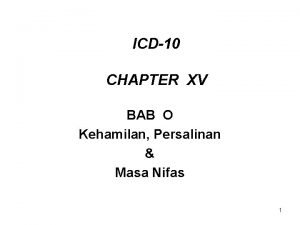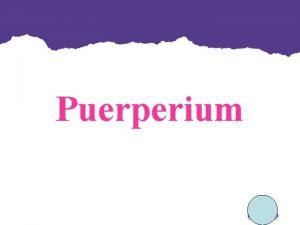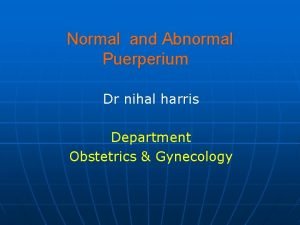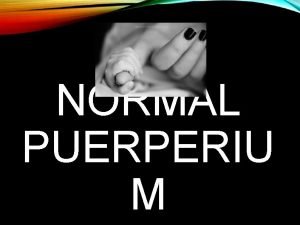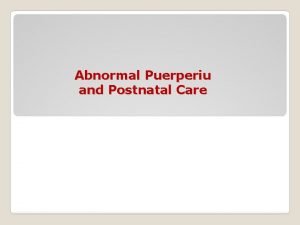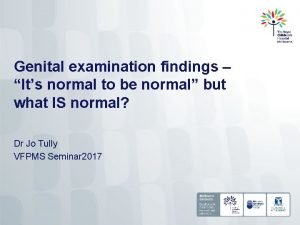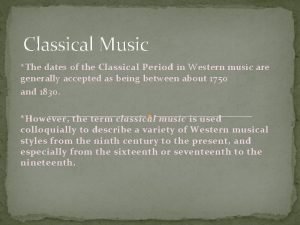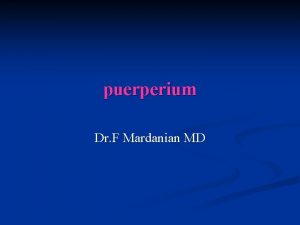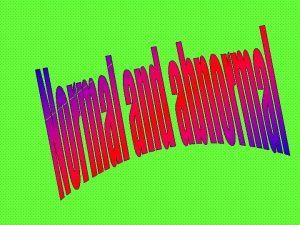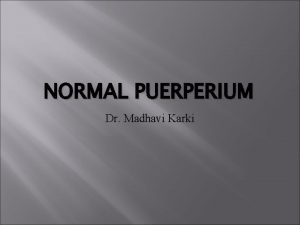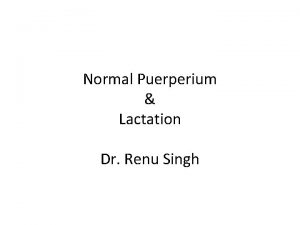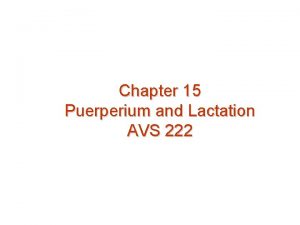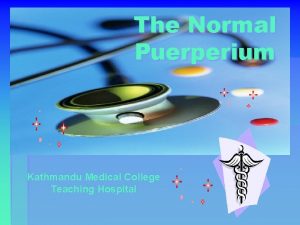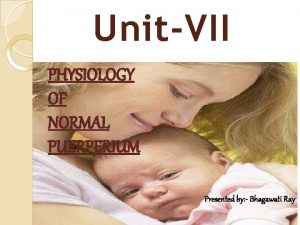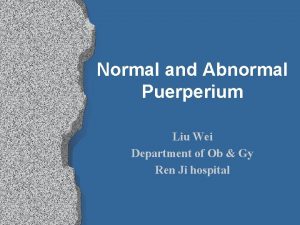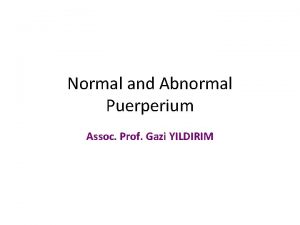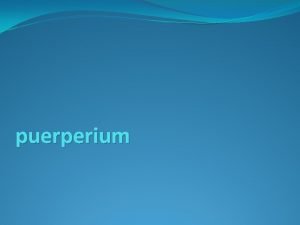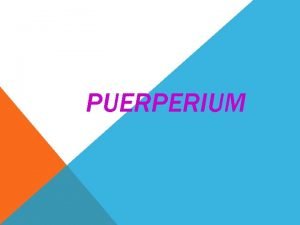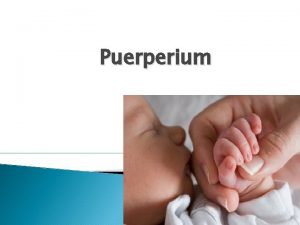NORMAL PUERPERIU M WHAT IS PUERPERIUM Period following




















- Slides: 20

NORMAL PUERPERIU M

WHAT IS PUERPERIUM? Period following childbirth Ø Pelvic organs & other body tissues Ø Revert to pre-pregnant state Ø Anatomically & physiologically Ø

Ø Ø Ø I. III. Begins as soon as placenta is expelled lasts for appx 6 weeks(42 days) 3 stages Immediate-within 24 hrs Early -upto 7 days Remote – upto 6 wks

INVOLUTION OF THE UTERUS Anatomical consideration ● At delivery-20 x 12 x 7. 5 cm and appox. 1000 g ● After involution-reverted to non-preg size of appox. 60 g ● Lower uterine segment isthmus in a few weeks ● Contour of cervix regained in 6 wks ● External os never reverts back to nulliparous state


Physiological Consideration Autolysis Ø Muscles: Steroid hormones withdrawn Myometrial cell size reduced Inc Collagenase & Proteolytic enzymes Endophlebitis Thrombosis Blood Vessels Fibrinoid end arteritis Ø Hyalinisation Endometrium: q q regen starts on day 7 from uterine gland mouths and interglandular stromal cells completed by day 16 except @ placental site

Clinical assessment of Involution of uterus • Fundus lies 13. 5 cm above sypmphysis pubis for the 1 st 24 hrs following delivery • Steady decrease by 0. 5'' in nxt 24 hrs • Day 14 - not palpable- pelvic organ • Completed by 6 wks

Long time d/t stretching during parturition Pelvic floor & Fascia 4 -8 weeks; Does not revert to original state Broad/round ligaments Vagina Involution of other Pelvic structures Long time d/t stretching during parturition

LOCHIA • Vaginal discharge for the 1 st fortnight during puerperium ● Odour: offensive fishy smell ● Colour and composition Lochia Rubra • 1 -4 days • Blood, fetal memb & decidua shreds, lanugo, meconium Lochi Serosa • 5 -6 days • Leucocytes, Cx mucus, wound exudates, microorganisms Lochia Alba • 10 -15 days • Decicual cells, leucocytes, mucus, cholestrin crystals, fatty epithelial cells, microorganisms

Clinical importance Malodorous Scanty/absent Excessive Red color persist L. Alba beyond 3 wks • Puerperal Sepsis dt E. Coli • Infection • Lochiometra • Infection • Subinvolution • Retained conceptus • Causes secondary PPH • Local genital infection

CHANGES IN BREAST & LACTATION Mamogenesis • Mammary duct-gland growth development Lactogenesis • Initiation Of milk secretion in Galactopoiesis Galactokinesis • Maintenance of Lactation • Removal of Milk from Gland

General Physiological Changes Ø Pulse: Ø Ø Temperature: Ø Ø Ø Pronounced Diuresis on 2 nd - 3 rd day over distension incomplete emptying presence of residual urine high risk of infection GIT: Ø Ø Ø Any rise above 0. 5 C suggestive of infection of genito-urinary tract Urinary Tract: Ø Ø raises but settles down to normal on 2 nd day increased thirst constipation Weight Loss: Ø Ø Ø 5 -6 kg expulsion of fetus placenta, liqour, blood 2 kg- during puerperium dt diuresis Continued upto 6 months of delivery

Ø Blood Values: Ø Ø Ø Menstruation: Ø Ø immediate-reduced blood volume; Normal in 2 weeks rise in cardiac output; Normal in 1 week leuycocyotsis dt stress Hypercoagulable state for 48 hrs Fibrinolytic activity enhanced in 4 days if not breast feeding- resumes in 6 to 8 wks Ovulation: Ø Ø Ø non-lactating mother- 4 wks lactating mother- 10 weeks Exclusive Breastfeeding- 98% contraception up 6 months

Management of normal Puerperium Ø To restore health of Mother Ø Ø Ø Ø Rest and Early ambulation Emotional support Diet of patients choice Sleep Immunization- anti-D- Gamma globulin Maternal-infant Bonding Postnatal exercise

Ø To prevent infection Care of bladder & Vulva ØCare of episiotomy wound ØMaintenance of asepsis and proper hygiene ØImmunization- Rubella vaccine, TT Ø To take care of the Breasts & promote breast feeding ØTo motivate mother for contraception Ø

Treatment of minor ailments • After pains • Uterus massage • Ibuprofen • Anti-spasmodic • Pain at site of perineum • Sitz bath • analgesics • Treatment of Anaemia • Supplementary Iron therapy

Abnormal Puerperium Ø Puerperal fever/ pyrexia Ø Puerperal Sepsis • Pelvic pain • Fever • Foul smelling vaginal discharge • Subinvolution

Ø Breast Problems • Retracted/cracked nipples • Breast engorgement • Mastitis • Breast abscess • Failure of lactation

Ø Urinary Problems • Retention • Incontinence • Infection Ø Venous thrombosis Ø Secondary Hemorrhage Ø Puerperal psychosis Ø Obstetric palsy

THANQ
 Phase of postpartum psychological adaptation
Phase of postpartum psychological adaptation Kode icd 10 letkep
Kode icd 10 letkep Lactating women meaning
Lactating women meaning Galactokinesis definition
Galactokinesis definition Nihal harris
Nihal harris Puerperiu.
Puerperiu. Purperium
Purperium The development of children 7th edition
The development of children 7th edition A&p flix activity: generation of an action potential
A&p flix activity: generation of an action potential When is the relative refractory period
When is the relative refractory period Critical period vs sensitive period
Critical period vs sensitive period Critical vs sensitive period examples
Critical vs sensitive period examples Critical period vs sensitive period
Critical period vs sensitive period Classical period started from 1750 to 1872
Classical period started from 1750 to 1872 Period 5 transition element 51 neutrons
Period 5 transition element 51 neutrons Activism period
Activism period Stability period vs measurement period
Stability period vs measurement period Trustee period and royal period
Trustee period and royal period Difference between history and prehistory
Difference between history and prehistory It's normal to be normal
It's normal to be normal What are the dates of the classical era?
What are the dates of the classical era?
